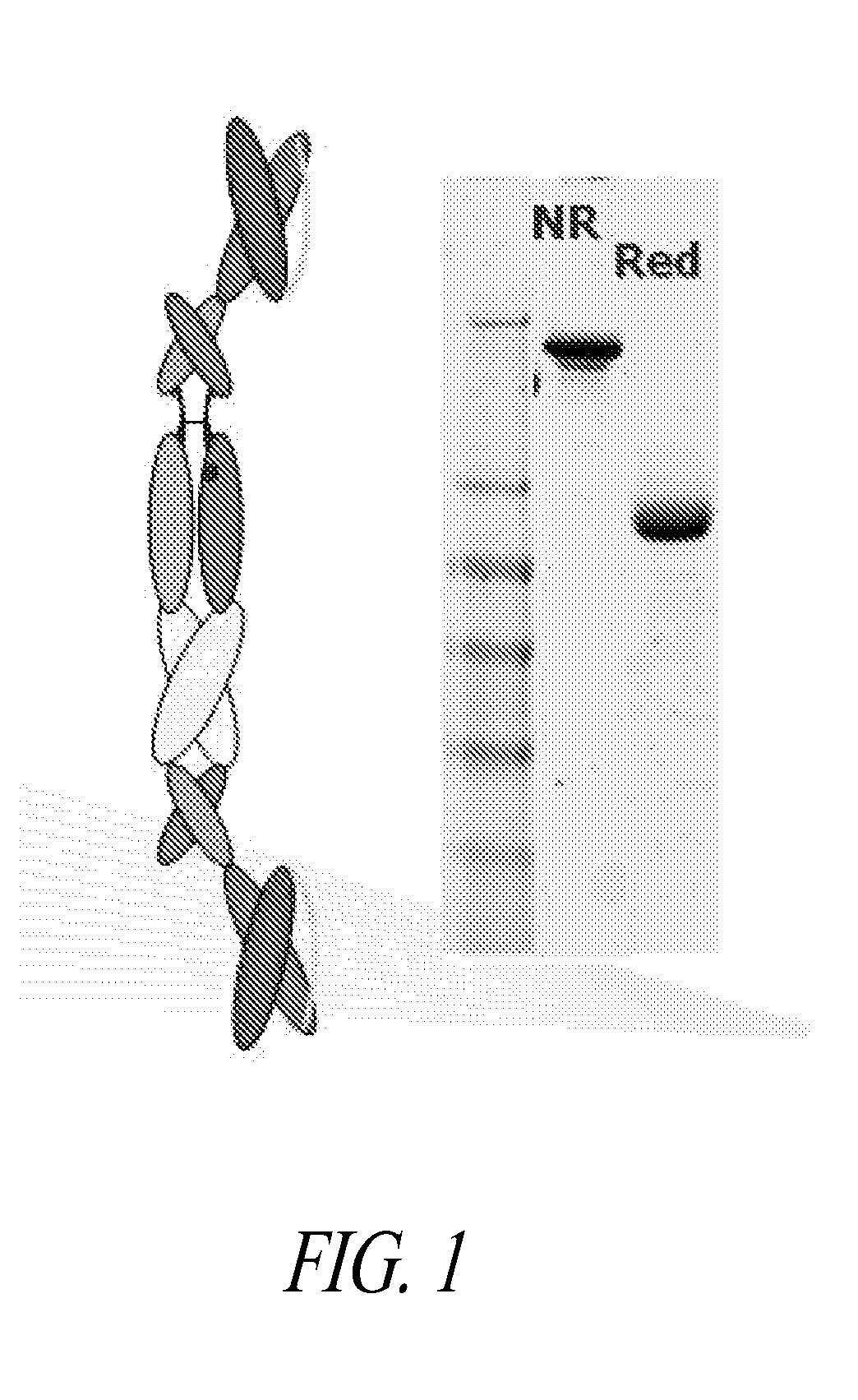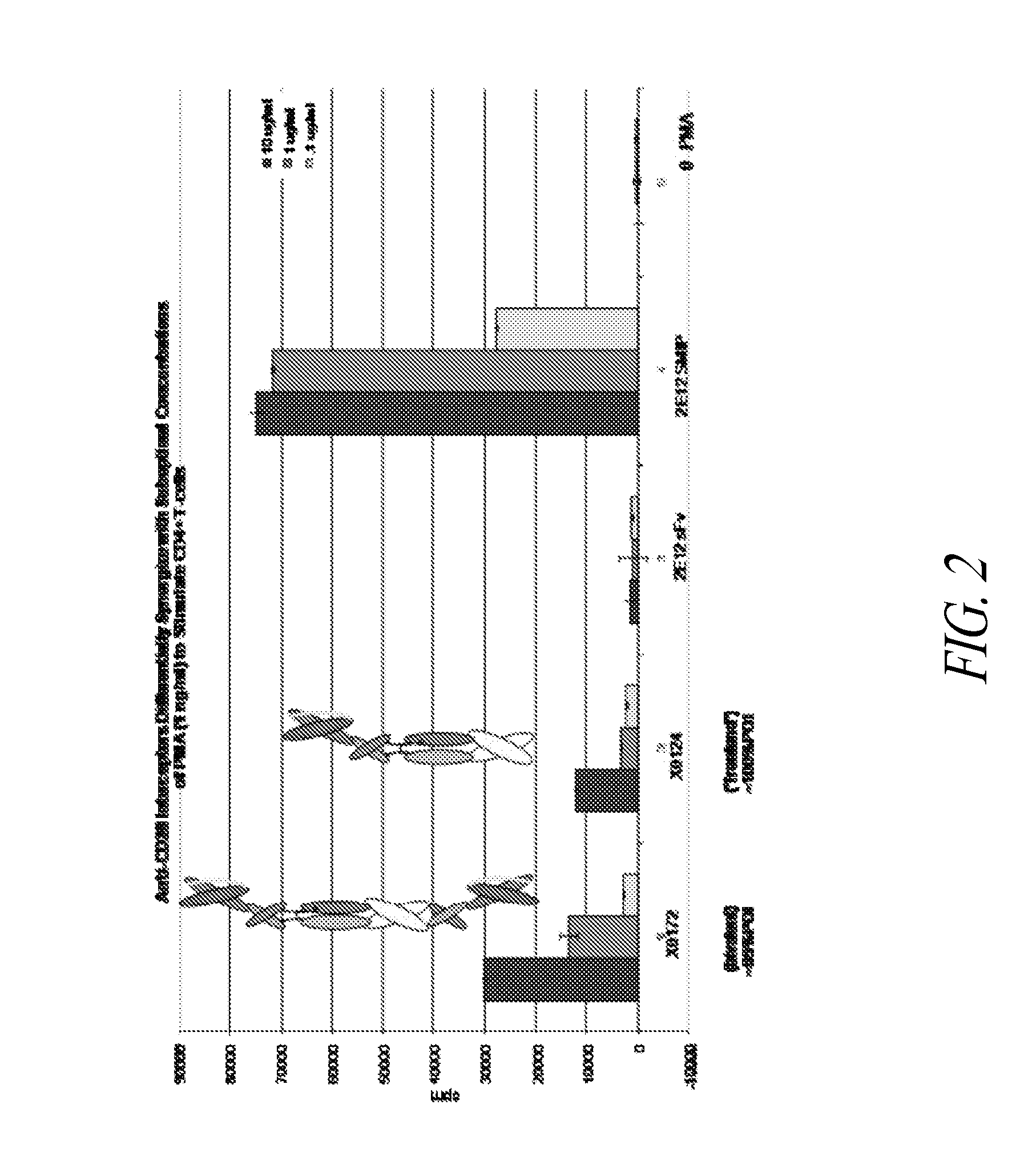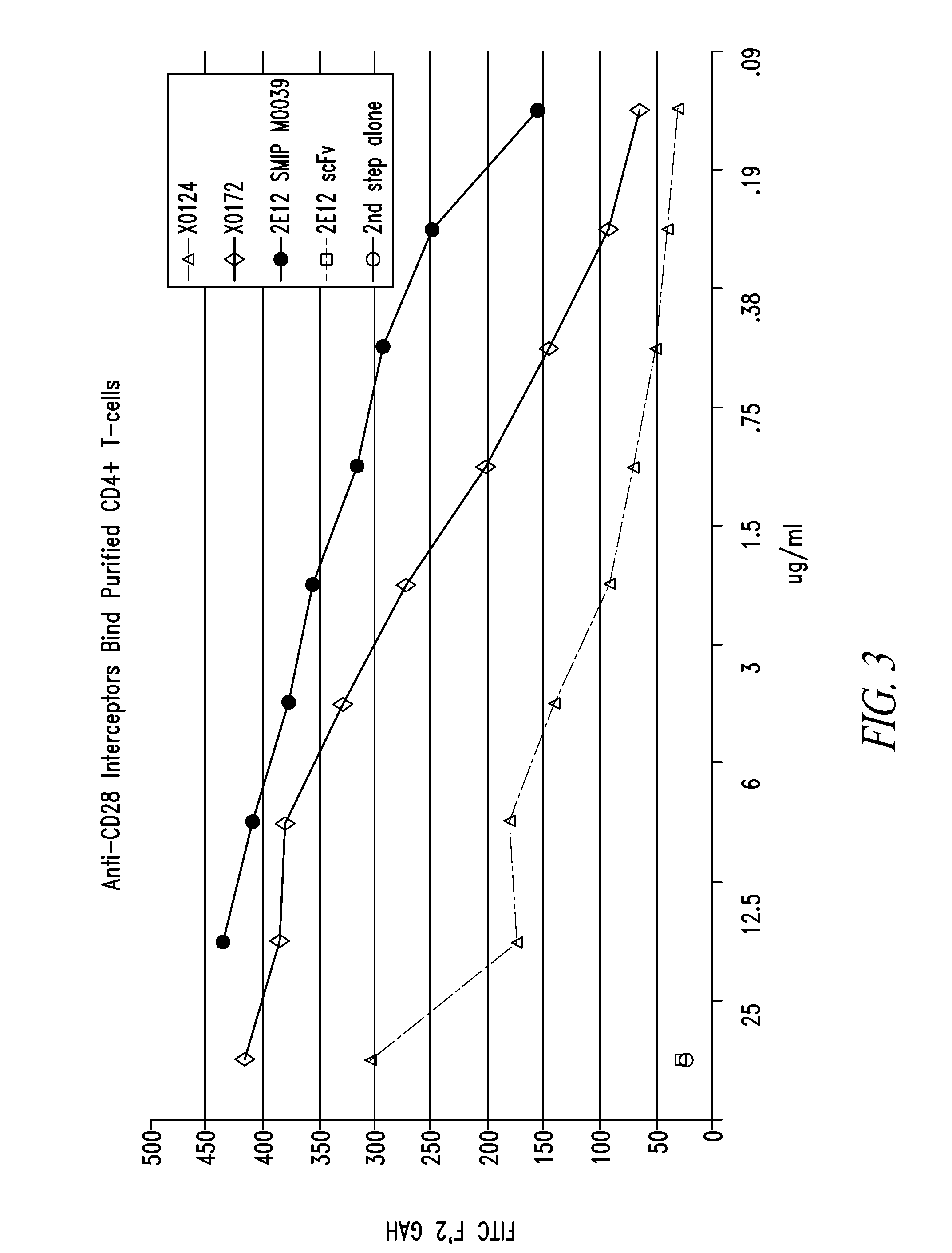Heterodimer Binding Proteins and Uses Thereof
a technology of heterodimer and binding protein, which is applied in the field of polypeptide heterodimer, can solve the problems of difficult purification from other products, difficult to produce materials of sufficient quality and quantity, and difficult to achieve preclinical and clinical studies
- Summary
- Abstract
- Description
- Claims
- Application Information
AI Technical Summary
Benefits of technology
Problems solved by technology
Method used
Image
Examples
example 1
Bivalent Polypeptide Heterodimer with Two Pairs of Heterodimerization Domains
[0367]Polypeptide heterodimer X0172 was made by co-expressing single chain polypeptides X0130 (2E12 CH1 CH2 CH3 Ck) and X0168 (Ck CH2 CH3 CH1 H68 2E12). Single chain polypeptide X0130 comprises, from its amino to carboxyl terminus: 2E12 (anti-CD28) scFv, human IgG1 CH1, human IgG1 SCC-P hinge, human IgG1 CH2, human IgG1 CH3, and altered human Ck (without the first Arg or the last Cys). The nucleic acid and amino acid sequences of X130 are set forth in SEQ ID NOS:1 and 2, respectively. Single chain polypeptide X0168 comprises, from its amino to carboxyl terminus: altered human Ck (without the first Arg or the last Cys), human IgG1 SCC-P hinge, human IgG1 CH2, human IgG1 CH3, human IgG1 CH1, H68 linker, and 2E12 (anti-CD28) scFv. The nucleic acid and amino acid sequences of X0168 are set forth in SEQ ID NOS:3 and 4, respectively. The amino acid sequence of H68 linker is set forth in SEQ ID NO:78.
[0368]For com...
example 2
Bivalent, Trivalent, Tetravalent Polypeptide Heterodimer Using Single Heterodimerization Domain Pair
[0377]Bivalent polypeptide heterodimer X0251 was made by co-expressing single chain polypeptides X0244 (Ck(YAE) CH2(N297A) CH3 H68 2E12) and X0245 (2E12 CH1 CH2(N297A) CH3). Single chain polypeptide X0244 comprises, from its amino to carboxyl terminus: human Ck(YAE) (i.e., human Ck without the first Arg or last Cys but with N30Y, V55A, and T70E substitutions), human IgG1 SCC-P hinge, human IgG1 CH2 (N297A) (i.e., human IgG1 CH2 with a N297A substitution), human IgG1 CH3, H68 linker, and 2E12 (anti-CD28) scFv. The nucleotide and amino acid sequences of X0244 are set forth in SEQ ID NOS:9 and 10, respectively. Single chain polypeptide X0245 comprises, from its amino to carboxyl terminus: 2E12 (anti-CD28) scFv, human IgG1 CH1, human IgG1 SCC-P hinge, human IgG1 CH2 (N297A), and human IgG1 CH3. The nucleotide and amino acid sequences of X0245 are set forth in SEQ ID NOS:11 and 12, respect...
example 3
Polypeptide Heterodimers with Anti-RON and Anti-c-Met Binding Domains
[0385]A bivalent polypeptide heterodimer with anti-RON binding domains (ORN151) and two bispecific polypeptide heterodimers comprising anti-RON and anti-cMet binding domains (ORN152 and ORN153) were made.
[0386]Bivalent polypeptide heterodimer ORN151 comprises single chain polypeptides ORN145 (4C04 CH2 CH3 CH1) and ORN148 (11H09CH2 CH3 Ck(YAE)). Single chain polypeptide ORN145 comprises from its amino to carboxyl terminus: 4C04 (anti-RON) scFv, human IgG1 SCC-P hinge, human IgG1 CH2, human IgG1 CH3 and human IgG1 CH1. The nucleotide and amino acid sequences of ORN145 are set forth in SEQ ID NOS:26 and 30, respectively. Single chain polypeptide ORN148 comprises from its amino to carboxyl terminus: 11H09 (anti-RON) scFv, human IgG1 SCC-P hinge, human CH2, human CH3, and human Ck(YAE). The nucleotide and amino acid sequences of ORN148 are set forth in SEQ ID NOS:28 and 32, respectively.
[0387]Bispecific (c-Met, RON) pol...
PUM
| Property | Measurement | Unit |
|---|---|---|
| equilibrium dissociation constant | aaaaa | aaaaa |
| length | aaaaa | aaaaa |
| size | aaaaa | aaaaa |
Abstract
Description
Claims
Application Information
 Login to View More
Login to View More - R&D
- Intellectual Property
- Life Sciences
- Materials
- Tech Scout
- Unparalleled Data Quality
- Higher Quality Content
- 60% Fewer Hallucinations
Browse by: Latest US Patents, China's latest patents, Technical Efficacy Thesaurus, Application Domain, Technology Topic, Popular Technical Reports.
© 2025 PatSnap. All rights reserved.Legal|Privacy policy|Modern Slavery Act Transparency Statement|Sitemap|About US| Contact US: help@patsnap.com



